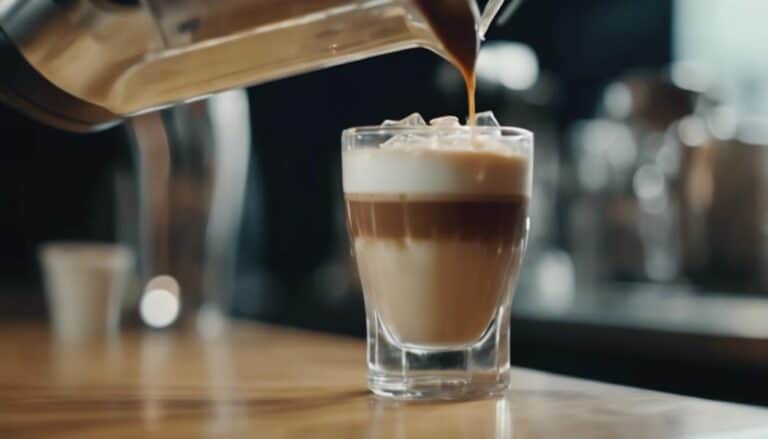Calories in a Cappuccino Coffee: Understanding Your Beverage’s Nutritional Profile

When we indulge in the frothy delight of a cappuccino, our enjoyment often comes with a side of curiosity regarding the calorie content of this popular espresso-based beverage. A traditional cappuccino, composed of equal parts espresso, steamed milk, and milk foam, can be both a comforting ritual and a treat for our taste buds. But as calorie-conscious individuals, we take an interest in understanding how this fits into our dietary goals.

On average, a standard 6-ounce cappuccino contains around 60 calories, assuming it’s made with whole milk. The calorie count may vary depending on the type and amount of milk used. If we opt for a larger serving size, say an 8-ounce cup, the calorie figure tends to increase. A typical 8-ounce cappuccino has approximately 80 calories.
However, it’s essential for us to note that these figures can change significantly when different milks are used or when additional ingredients such as sugar, syrups, or flavorings are added. For those of us who favor plant-based milk alternatives or low-fat options, the calorie count of a cappuccino may be reduced. It is thus crucial for us to consider the specific components of our cappuccino in order to accurately account for its caloric impact.
Basic Composition of a Cappuccino

We’ll explore the specific components of a cappuccino, focusing on its nutritional content, including calories, proteins, fats, carbohydrates, sugars, and essential vitamins and minerals. Understanding these elements will help you appreciate the dietary implications of enjoying this classic coffee beverage.
Caloric Content
A typical 6-ounce cappuccino made with full-cream milk contains approximately 60 calories, which can vary based on milk choice and serving size. For those opting for a larger 8-ounce serving, the calorie count is about 80 calories. Remember, these values can differ based on milk type and additional ingredients like sugar.
Proteins and Fats in Cappuccino
The protein content in a cappuccino primarily comes from milk, with a standard 8-ounce cup offering around 5 grams of protein. As for fats, this serving size generally has 3.98 grams of total fat, which includes 2.273 grams of saturated fat and negligible amounts of trans, polyunsaturated, and monounsaturated fats.
Carbohydrates and Sugars
Carbohydrates in a cappuccino are found in the form of lactose from milk and any added sugars. An 8-ounce serving typically has 5.81 grams of total carbohydrates, which includes sugars. If sugar is added, the carbohydrate content will increase, with each teaspoon of sugar contributing about 4 grams of carbs.
Vitamins and Minerals
Although not a significant source, a cappuccino offers minimal amounts of vitamins and minerals such as calcium from milk, which is essential for bone health. Other micronutrients like vitamin A, vitamin D, iron, and potassium can be found in small quantities. While coffee itself adds negligible nutritional value, it does contribute a modest amount of vitamin C and potassium.
Types of Cappuccino and Variations

In this section, we delve into the nuanced world of cappuccinos, exploring how they can vary from the traditional rendition to modern twists that cater to diverse preferences and dietary requirements. We will examine the role of ingredients like the type of milk and espresso, and how they influence the cappuccino’s rich texture and flavor.
Traditional vs. Modern Cappuccino
Traditional Cappuccino: At its heart, a traditional cappuccino comprises equal parts of espresso, steamed milk, and milk foam. This classic combination creates a harmonious balance and a velvety texture that’s beloved around the world.
Modern Cappuccino: Modern variations often push the boundaries of the original by altering the proportions or components. For instance, baristas may use a decaffeinated espresso for those who prefer it, or vary the type of milk to alter the drink’s richness and caloric content, including options like reduced-fat or nonfat milk.
Flavored Cappuccinos
Flavored cappuccinos add a twist to the classic with a range of syrups and spices. Popular variants include the Donut Shop Cinnamon Dulce Cappuccino, where cinnamon and sweet notes evoke a freshly baked treat. Another crowd-pleaser is the Hills Bros. English Toffee Cappuccino, with its 40g serving enveloping the palate in a nutty, caramel allure.
Diet-Specific Cappuccinos
With dietary preferences and health consciousness on the rise, cappuccinos have also evolved. For those limiting their calorie intake, a nonfat cappuccino cuts down on calories without compromising the espresso’s bold presence. Meanwhile, lactose-intolerant consumers might opt for milk alternatives like soy or almond to customize their cappuccino without sacrificing taste or texture.
Impact on Health and Diet

When considering the role of a cappuccino in your diet, it’s essential to acknowledge how its caloric content fits into your overall nutrition plan and weight management strategy. We will examine the calories a typical cappuccino contains and how this relates to daily value recommendations.
Calories and Weight Management
A cappuccino generally contains a mix of espresso and steamed milk. The calories in a standard cappuccino made with whole milk range around 100 to 150 calories per 8 oz serving. If you’re using a calorie counter or a food database to manage a weight loss effort, it’s crucial to record this intake. Altering the type of milk can change the calorie content significantly, with skim milk options providing fewer calories.
- A single shot of espresso with 2 ounces of steamed milk: 64 calories
- With a tablespoon of sweetened condensed milk, calories increase to: 90 calories
Limiting added sugars and syrups can help keep your cappuccino within a lower calorie range, supporting your diet regimen.
Understanding Daily Values
Our daily caloric needs can vary, but general nutrition advice suggests a daily intake of around 2,000 to 2,500 calories, depending on various factors like age, sex, and physical activity levels. A cappuccino’s calories should be balanced within the recommended daily intake to maintain a healthy diet.
- Percent of calorie intake for a 2,000 calorie/day diet from a standard cappuccino: 5% to 7.5%
- For a diet regimen emphasizing calorie control, choosing low-calorie milk options may make a cappuccino more suitable.
It’s wise to be mindful of your calorie intake from beverages as part of your overall strategy, ensuring you meet your nutrient needs without exceeding your daily values.
Cappuccino Alternatives and Comparisons
When considering a cappuccino, it’s useful to explore how it stacks up against other coffee drinks and various beverages in terms of calorie content. We’ll focus on specific comparisons to give you a clearer picture of what to expect from each option.
Cappuccino vs. Other Coffees
Latte: While a cappuccino typically contains equal parts espresso, steamed milk, and foam, a latte has more steamed milk and just a light layer of foam. This results in a latte generally having more calories; for instance, a 12-ounce serving with whole milk can have around 210 calories compared to a cappuccino with approximately 130 calories for the same size.
Macchiato: A macchiato, comprised mainly of espresso with just a dollop of foam or milk, is usually lower in calories than a cappuccino due to the smaller amount of milk. A traditional single shot macchiato would significantly undercut even a small cappuccino’s 64 calories.
Starbucks Cappuccino (Grande): Weighing in at 16 ounces, our Starbucks Grande Cappuccino holds more milk and therefore more calories than its smaller counterpart, the Tall.
Starbucks Cappuccino (Tall): The Tall cappuccino from Starbucks is a 12-ounce serving with a caloric content that aligns closely with the general figure mentioned earlier for a standard cappuccino of similar size.
Cappuccino vs. Other Beverages
Celsius Energy Drink: When compared to a cappuccino, energy drinks like Celsius offer a different kind of experience focused on energy-boosting elements. Celsius contains around 10 calories per can, significantly fewer than what’s found in cappuccinos.
High Brew Cold Brew Coffee: Cold brew options like High Brew may vary in calorie count based on added sugar or cream, but plain cold brew coffee is often lower in calories than a cappuccino due to the absence of milk.
Tropical Smoothie Cafe: Beverages from cafes such as Tropical Smoothie Cafe often have a higher calorie count due to their fruit, yogurts, and additional sweeteners. For example, their smoothies can range significantly, often climbing over the calorie count of a standard cappuccino.
Simply Smoothie: Pre-made smoothies like Simply Smoothie generally list their calorie contents on the packaging, which often exceed the caloric intake one would get from a standard cappuccino if fruits and sugars are plentiful in the mix.
Protein2O Wild Cherry: Flavored water options that contain protein, like Protein2O Wild Cherry, can provide a low-calorie alternative with the added benefit of protein, usually running lower in calories than a traditional cappuccino.
It’s clear that our choices range widely in terms of calorie content, and when opting for a cappuccino, we’re choosing a drink that sits moderately on the calorie scale in comparison to other beverages.
Choosing the Right Cappuccino
When selecting the perfect cappuccino, we consider factors such as brand, whether it’s homemade or store-bought, and how each choice impacts calorie intake and flavor experience.
Selecting by Brand
Starbucks, a well-known coffee house accessible around the globe, offers cappuccinos that cater to those watching their caloric intake while enjoying a rich coffee flavor. We can select Skimmed Milk Options to keep the calorie count low, as a 12-ounce Starbucks cappuccino typically contains around 120 calories. On the other hand, convenience stores like 7-Eleven or Wawa might offer a cappuccino with more varying calorie counts, often due to the type of cappuccino flavor powder and sugar content used.
For coffee lovers who prefer brews from specific brands, Trader Joe’s and Cracker Barrel provide unique options. While Trader Joe’s has a reputation for its diverse grocery selection, including instant coffee and specialty coffee-related products, Cracker Barrel, often recognized for its homestyle meals, also offers a comforting coffee experience that may come with a higher calorie content.
Homemade vs. Store-Bought
When we make cappuccinos at home, we can control serving sizes to manage our calorie intake more effectively, which we can conveniently track using a food diary. Homemade cappuccinos allow for the flexibility of using different milk types, like almond or soy, which can affect the overall calorie content. For instance, a standard homemade 6-ounce cappuccino could be around 60 calories depending on the milk used.
Conversely, store-bought cappuccinos, like the ones from Nescafe or the Swiss Miss Indulgent Collection Mocha Cappuccino Hot Cocoa Mix, can vary in calories, often due to added sugars and flavorings. An example would be the Swiss Miss Indulgent Collection Mocha Cappuccino Hot Cocoa Mix which can have significantly more calories than a typical homemade cappuccino due to its rich mix ingredients.
Final Thoughts
When we consider the nutritional values of a cappuccino, we must account for the ingredients typically involved: espresso, steamed milk, and often, milk foam. Our choice of sweeteners or additional cream can significantly impact the calorie count.
-
Plain Cappuccino: For a standard cappuccino, consisting of a single shot of espresso and 2 ounces of steamed milk, we’re looking at approximately 64 calories.
-
With Sweetened Condensed Milk: Should we opt to enrich our beverage with a tablespoon of sweetened condensed milk, the calories can rise to around 90 calories.
It’s crucial to remember that these figures are estimates and may vary based on the size of the cup and precise amounts of each component used.
For those of us who are health-conscious or watching our caloric intake, it’s wise to be mindful of what we add to our cappuccino. A shift from full-fat milk to skim milk could render our drink a more low-calorie choice, but this benefits only those who appreciate a less creamy texture.
On the other hand, if indulgence is our aim, adding whipped cream or flavored syrups will undoubtedly increase the calorie content, possibly transforming our humble cup into a dessert.
Our takeaway? We have the power to control the nutritional value of our cappuccino. By making informed decisions about the ingredients, we can tailor our coffee experience to suit our dietary preferences and requirements.
References
When discussing the caloric content of cappuccino coffee, we cite several reliable sources to provide you with accurate information. Below, we’ve organized our references to ensure easy access to the data we’ve compiled.
Caloric Breakdown:
- A typical cappuccino made with full-cream milk in a 6-ounce cup carries an average of 60 calories. Full Coffee Roast offers a detailed analysis of these figures.
- For a standard 8-ounce cappuccino, the caloric intake is approximately 80 calories with minimal fat content. Details on these measurements can be found on Coffee Pursuing.
Nutritional Content:
- FatSecret provides nutritional facts for a mug of cappuccino (8 fl oz), reporting 74 calories and a breakdown of fats, cholesterol, and carbohydrates. See the full nutrition facts at FatSecret’s Cappuccino Calories.
- Additionally, nutritional values for a medium-sized cappuccino are listed on FatSecret, which includes information on calories, fats, and sugars. Find the specifics at 1 medium Cappuccino Nutrition Facts.
Commercial Coffee Chains:
- Starbucks provides detailed nutritional information for their cappuccino servings. A Grande (16 fl oz) cappuccino contains 140 calories. Visit Starbucks Coffee Company for their complete nutritional information.
We ensure that the data provided is up to date and reflects the caloric content found in a typical serving of cappuccino. By consulting these sources, you can make informed choices about your coffee consumption.





